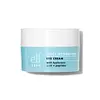What's inside
What's inside
 Key Ingredients
Key Ingredients

 Benefits
Benefits

 Concerns
Concerns

 Ingredients Side-by-side
Ingredients Side-by-side

Water
Skin ConditioningGlycerin
HumectantCaprylic/Capric Triglyceride
MaskingGlyceryl Stearate Citrate
EmollientJojoba Esters
EmollientDiisostearyl Malate
EmollientC10-18 Triglycerides
EmollientCetearyl Alcohol
EmollientSilica
AbrasivePalmitoyl Tripeptide-1
Skin ConditioningPalmitoyl Tetrapeptide-7
Skin ConditioningSoluble Collagen
HumectantSodium Hyaluronate
HumectantTocopherol
AntioxidantHelianthus Annuus Seed Oil
EmollientButylene Glycol
Humectant1,2-Hexanediol
Skin ConditioningPotassium Cetyl Phosphate
EmulsifyingPolysorbate 20
EmulsifyingPolysorbate 80
EmulsifyingIsohexadecane
EmollientSodium Acrylate/Sodium Acryloyldimethyl Taurate Copolymer
Emulsion StabilisingCarbomer
Emulsion StabilisingHydroxyacetophenone
AntioxidantDisodium EDTA
Water, Glycerin, Caprylic/Capric Triglyceride, Glyceryl Stearate Citrate, Jojoba Esters, Diisostearyl Malate, C10-18 Triglycerides, Cetearyl Alcohol, Silica, Palmitoyl Tripeptide-1, Palmitoyl Tetrapeptide-7, Soluble Collagen, Sodium Hyaluronate, Tocopherol, Helianthus Annuus Seed Oil, Butylene Glycol, 1,2-Hexanediol, Potassium Cetyl Phosphate, Polysorbate 20, Polysorbate 80, Isohexadecane, Sodium Acrylate/Sodium Acryloyldimethyl Taurate Copolymer, Carbomer, Hydroxyacetophenone, Disodium EDTA
Water
Skin ConditioningButylene Glycol
HumectantTetrahexyldecyl Ascorbate
AntioxidantC9-12 Alkane
SolventTocopheryl Acetate
AntioxidantBambusa Arundinacea Stem Powder
AbrasivePEG-100 Stearate
Cetyl Ricinoleate
EmollientFerulic Acid
AntimicrobialButyrospermum Parkii Butter
Skin ConditioningBehenyl Alcohol
EmollientMethyl Trimethicone
Skin ConditioningGlycerin
HumectantCarbomer
Emulsion StabilisingMethyldihydrojasmonate
MaskingPolymethylsilsesquioxane
Saccharomyces Ferment Filtrate
HumectantHydrogenated Lecithin
EmulsifyingDiamond Powder
AbrasiveCaffeine
Skin ConditioningSodium Hyaluronate
HumectantUbiquinone
AntioxidantEthylhexylglycerin
Skin ConditioningSqualane
EmollientSoluble Collagen
HumectantUndaria Pinnatifida Extract
Skin ConditioningCaesalpinia Spinosa Fruit Extract
Skin ProtectingArnica Montana Flower Extract
MaskingOlea Europaea Fruit Oil
MaskingCorallina Officinalis Extract
Skin ConditioningKappaphycus Alvarezii Extract
Skin ConditioningTribehenin
EmollientC12-15 Alkyl Benzoate
AntimicrobialCoco-Caprylate/Caprate
EmollientCaprylic/Capric Triglyceride
MaskingJojoba Wax PEG-120 Esters
Sodium Hydroxide
BufferingMyristyl Alcohol
EmollientSteareth-20
CleansingMica
Cosmetic ColorantSodium Benzoate
MaskingPotassium Sorbate
PreservativePhenoxyethanol
PreservativeWater, Butylene Glycol, Tetrahexyldecyl Ascorbate, C9-12 Alkane, Tocopheryl Acetate, Bambusa Arundinacea Stem Powder, PEG-100 Stearate, Cetyl Ricinoleate, Ferulic Acid, Butyrospermum Parkii Butter, Behenyl Alcohol, Methyl Trimethicone, Glycerin, Carbomer, Methyldihydrojasmonate, Polymethylsilsesquioxane, Saccharomyces Ferment Filtrate, Hydrogenated Lecithin, Diamond Powder, Caffeine, Sodium Hyaluronate, Ubiquinone, Ethylhexylglycerin, Squalane, Soluble Collagen, Undaria Pinnatifida Extract, Caesalpinia Spinosa Fruit Extract, Arnica Montana Flower Extract, Olea Europaea Fruit Oil, Corallina Officinalis Extract, Kappaphycus Alvarezii Extract, Tribehenin, C12-15 Alkyl Benzoate, Coco-Caprylate/Caprate, Caprylic/Capric Triglyceride, Jojoba Wax PEG-120 Esters, Sodium Hydroxide, Myristyl Alcohol, Steareth-20, Mica, Sodium Benzoate, Potassium Sorbate, Phenoxyethanol
Ingredients Explained
These ingredients are found in both products.
Ingredients higher up in an ingredient list are typically present in a larger amount.
Butylene Glycol (or BG) is used within cosmetic products for a few different reasons:
Overall, Butylene Glycol is a safe and well-rounded ingredient that works well with other ingredients.
Though this ingredient works well with most skin types, some people with sensitive skin may experience a reaction such as allergic rashes, closed comedones, or itchiness.
Learn more about Butylene GlycolThis ingredient is an emollient, solvent, and texture enhancer. It is considered a skin-softener by helping the skin prevent moisture loss.
It helps thicken a product's formula and makes it easier to spread by dissolving clumping compounds.
Caprylic Triglyceride is made by combining glycerin with coconut oil, forming a clear liquid.
While there is an assumption Caprylic Triglyceride can clog pores due to it being derived from coconut oil, there is no research supporting this.
Learn more about Caprylic/Capric TriglycerideCarbomer is a polymer of acrylic acid. Its main role is to create a gel consistency.
A high amount of carbomer can cause pilling or balling up of products. Don't worry, most products contain 1% or less of carbomer.
Glycerin is already naturally found in your skin. It helps moisturize and protect your skin.
A study from 2016 found glycerin to be more effective as a humectant than AHAs and hyaluronic acid.
As a humectant, it helps the skin stay hydrated by pulling moisture to your skin. The low molecular weight of glycerin allows it to pull moisture into the deeper layers of your skin.
Hydrated skin improves your skin barrier; Your skin barrier helps protect against irritants and bacteria.
Glycerin has also been found to have antimicrobial and antiviral properties. Due to these properties, glycerin is often used in wound and burn treatments.
In cosmetics, glycerin is usually derived from plants such as soybean or palm. However, it can also be sourced from animals, such as tallow or animal fat.
This ingredient is organic, colorless, odorless, and non-toxic.
Glycerin is the name for this ingredient in American English. British English uses Glycerol/Glycerine.
Learn more about GlycerinSodium Hyaluronate is hyaluronic acid's salt form. It is commonly derived from the sodium salt of hyaluronic acid.
Like hyaluronic acid, it is great at holding water and acts as a humectant. This makes it a great skin hydrating ingredient.
Sodium Hyaluronate is naturally occurring in our bodies and is mostly found in eye fluid and joints.
These are some other common types of Hyaluronic Acid:
Learn more about Sodium HyaluronateSoluble collagen comes from animals and fish. It has a large molecule size, meaning it doesn't get absorbed into skin.
Instead, it sits on top of skin as a humectant to improve skin hydration. It has incredible water-binding properties and creates a water barrier on skin that prevents evaporation.
This ingredient is incredibly gentle and often used to counter more irritating ingredients.
While our skin does have collagen, this ingredient is not used by the skin for anti-aging. Applying collagen topically has not been linked to helping with collagen loss in skin. All the benefits of soluble collagen are related to hydration.
Fun fact: The name "soluble collagen" refers to its ability to dissolve in water.
Learn more about Soluble CollagenWater. It's the most common cosmetic ingredient of all. You'll usually see it at the top of ingredient lists, meaning that it makes up the largest part of the product.
So why is it so popular? Water most often acts as a solvent - this means that it helps dissolve other ingredients into the formulation.
You'll also recognize water as that liquid we all need to stay alive. If you see this, drink a glass of water. Stay hydrated!
Learn more about Water